2009 TOYOTA COROLLA battery
[x] Cancel search: batteryPage 406 of 468
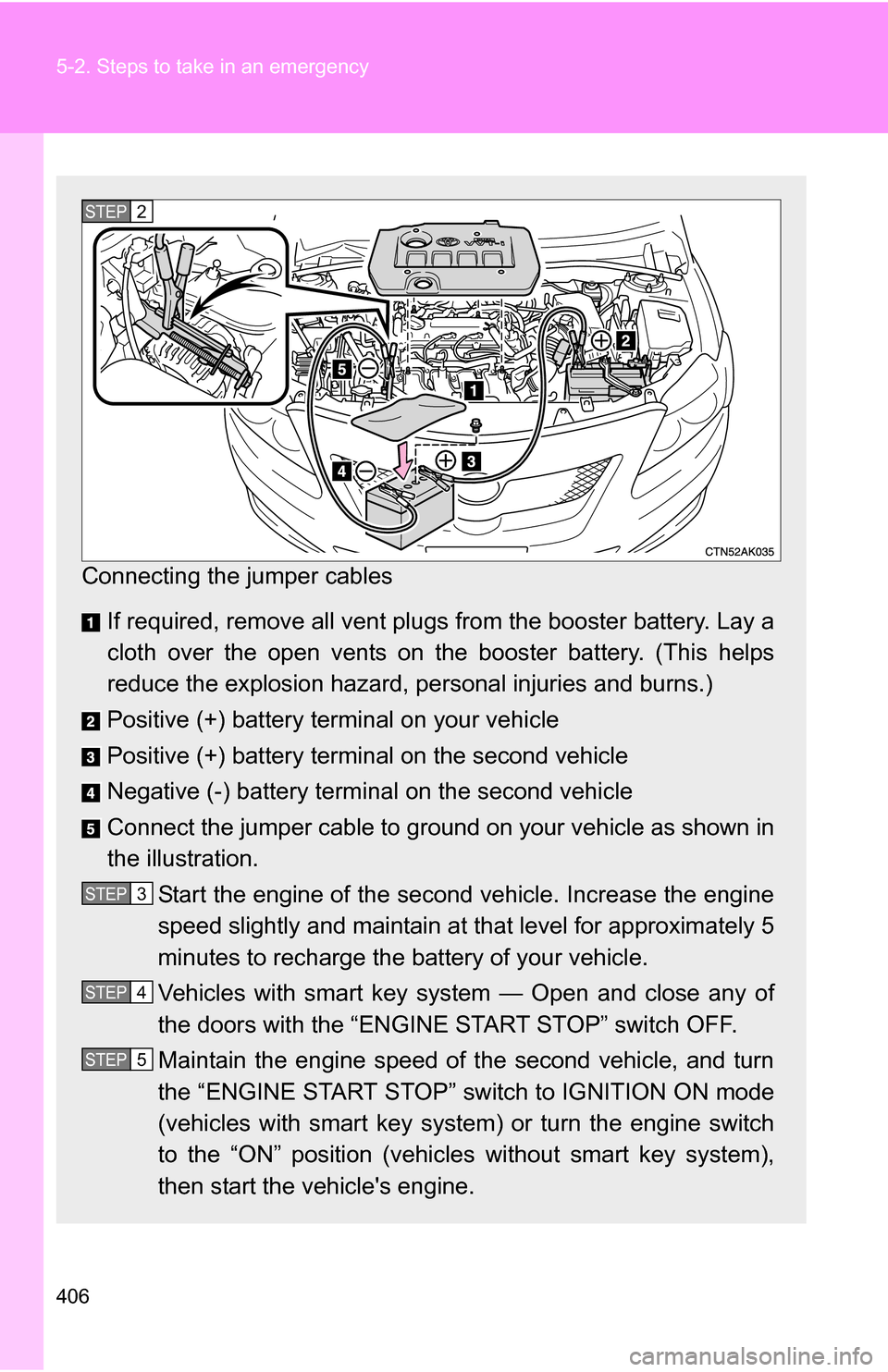
406 5-2. Steps to take in an emergency
Connecting the jumper cables If required, remove all vent plugs from the booster battery. Lay a
cloth over the open vents on t he booster battery. (This helps
reduce the explosion hazard, personal injuries and burns.)
Positive (+) battery terminal on your vehicle
Positive (+) battery terminal on the second vehicle
Negative (-) battery terminal on the second vehicle
Connect the jumper cable to ground on your vehicle as shown in
the illustration.
Start the engine of the second vehicle. Increase the engine
speed slightly and maintain at that level for approximately 5
minutes to recharge the battery of your vehicle.
Vehicles with smart key system — Open and close any of
the doors with the “ENGINE START STOP” switch OFF.
Maintain the engine speed of the second vehicle, and turn
the “ENGINE START STOP” switch to IGNITION ON mode
(vehicles with smart key system) or turn the engine switch
to the “ON” position (vehicles without smart key system),
then start the vehicle's engine.
STEP2
STEP3
STEP4
STEP5
Page 407 of 468
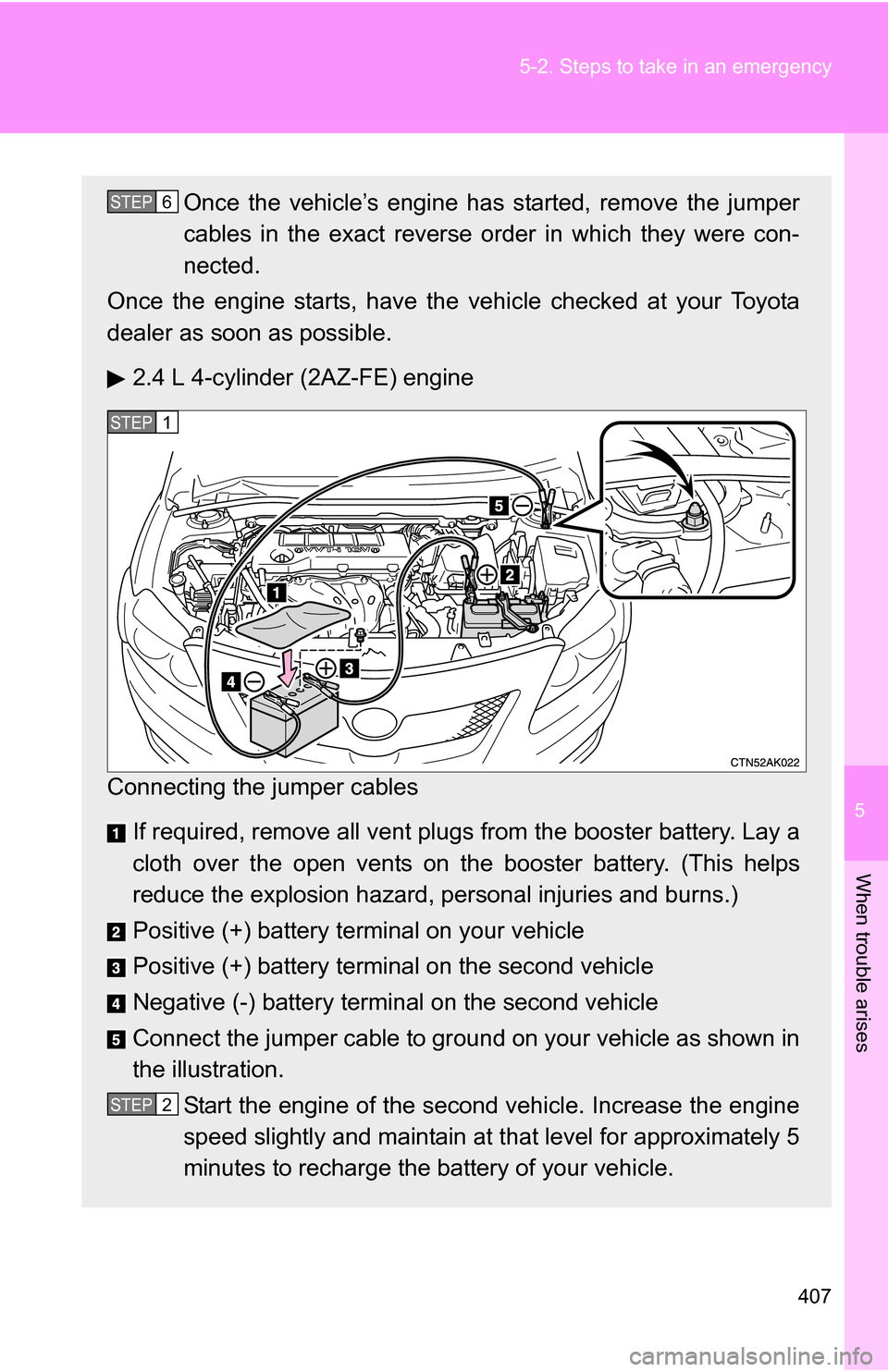
5
When trouble arises
407
5-2. Steps to take in an emergency
Once the vehicle’s engine has started, remove the jumper
cables in the exact reverse order in which they were con-
nected.
Once the engine starts, have the vehicle checked at your Toyota
dealer as soon as possible.
2.4 L 4-cylinder (2AZ-FE) engine
Connecting the jumper cables If required, remove all vent plugs from the booster battery. Lay a
cloth over the open vents on t he booster battery. (This helps
reduce the explosion hazard, personal injuries and burns.)
Positive (+) battery terminal on your vehicle
Positive (+) battery terminal on the second vehicle
Negative (-) battery terminal on the second vehicle
Connect the jumper cable to ground on your vehicle as shown in
the illustration.
Start the engine of the second vehicle. Increase the engine
speed slightly and maintain at that level for approximately 5
minutes to recharge the battery of your vehicle.STEP6
STEP1
STEP2
Page 408 of 468
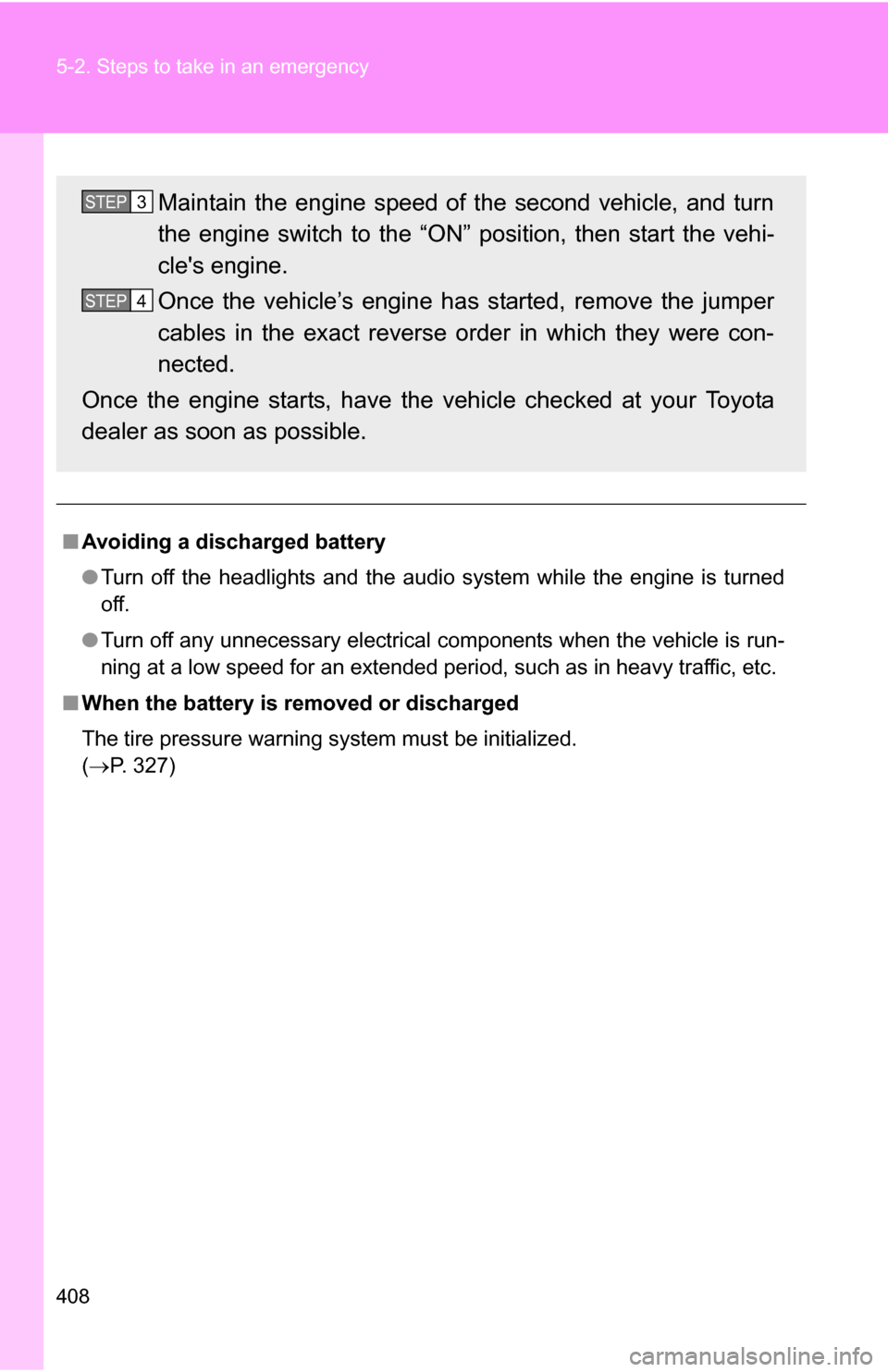
408 5-2. Steps to take in an emergency
■Avoiding a discharged battery
●Turn off the headlights and the audio system while the engine is turned
off.
● Turn off any unnecessary electrical components when the vehicle is run-
ning at a low speed for an extended period, such as in heavy traffic, etc.
■ When the battery is removed or discharged
The tire pressure warning system must be initialized.
(P. 327)
Maintain the engine speed of the second vehicle, and turn
the engine switch to the “ON” position, then start the vehi-
cle's engine.
Once the vehicle’s engine has started, remove the jumper
cables in the exact reverse order in which they were con-
nected.
Once the engine starts, have the vehicle checked at your Toyota
dealer as soon as possible.STEP3
STEP4
Page 409 of 468
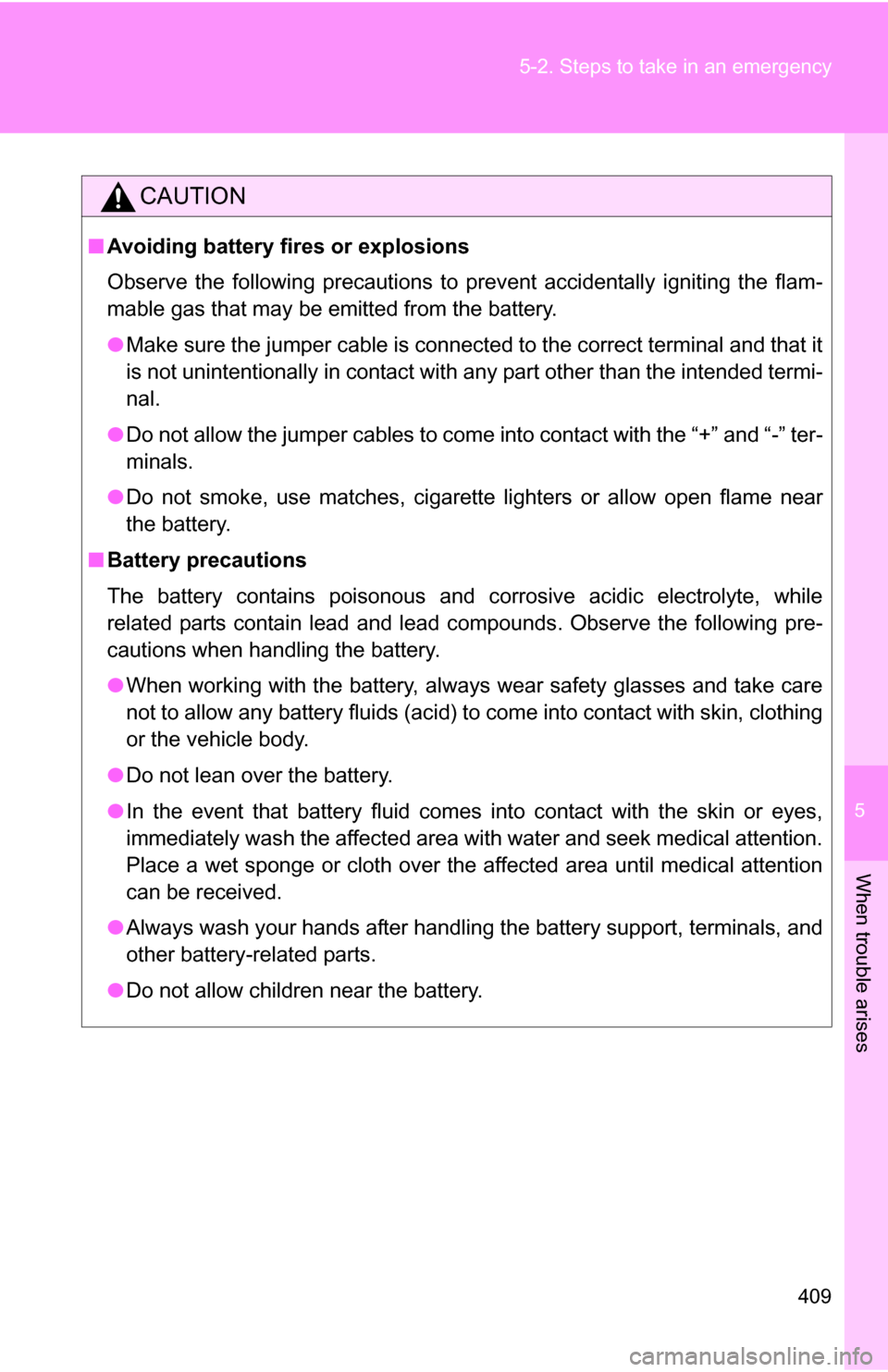
5
When trouble arises
409
5-2. Steps to take in an emergency
CAUTION
■
Avoiding battery fires or explosions
Observe the following precautions to prevent accidentally igniting the flam-
mable gas that may be emitted from the battery.
●Make sure the jumper cable is connected to the correct terminal and that it
is not unintentionally in contact with any part other than the intended termi-
nal.
● Do not allow the jumper cables to come into contact with the “+” and “-” ter-
minals.
● Do not smoke, use matches, cigarette lighters or allow open flame near
the battery.
■ Battery precautions
The battery contains poisonous and corrosive acidic electrolyte, while
related parts contain lead and lead compounds. Observe the following pre-
cautions when handling the battery.
●When working with the battery, always wear safety glasses and take care
not to allow any battery fluids (acid) to come into contact with skin, clothing
or the vehicle body.
● Do not lean over the battery.
● In the event that battery fluid comes into contact with the skin or eyes,
immediately wash the affected area with water and seek medical attention.
Place a wet sponge or cloth over the affected area until medical attention
can be received.
● Always wash your hands after handling the battery support, terminals, and
other battery-related parts.
● Do not allow children near the battery.
Page 423 of 468
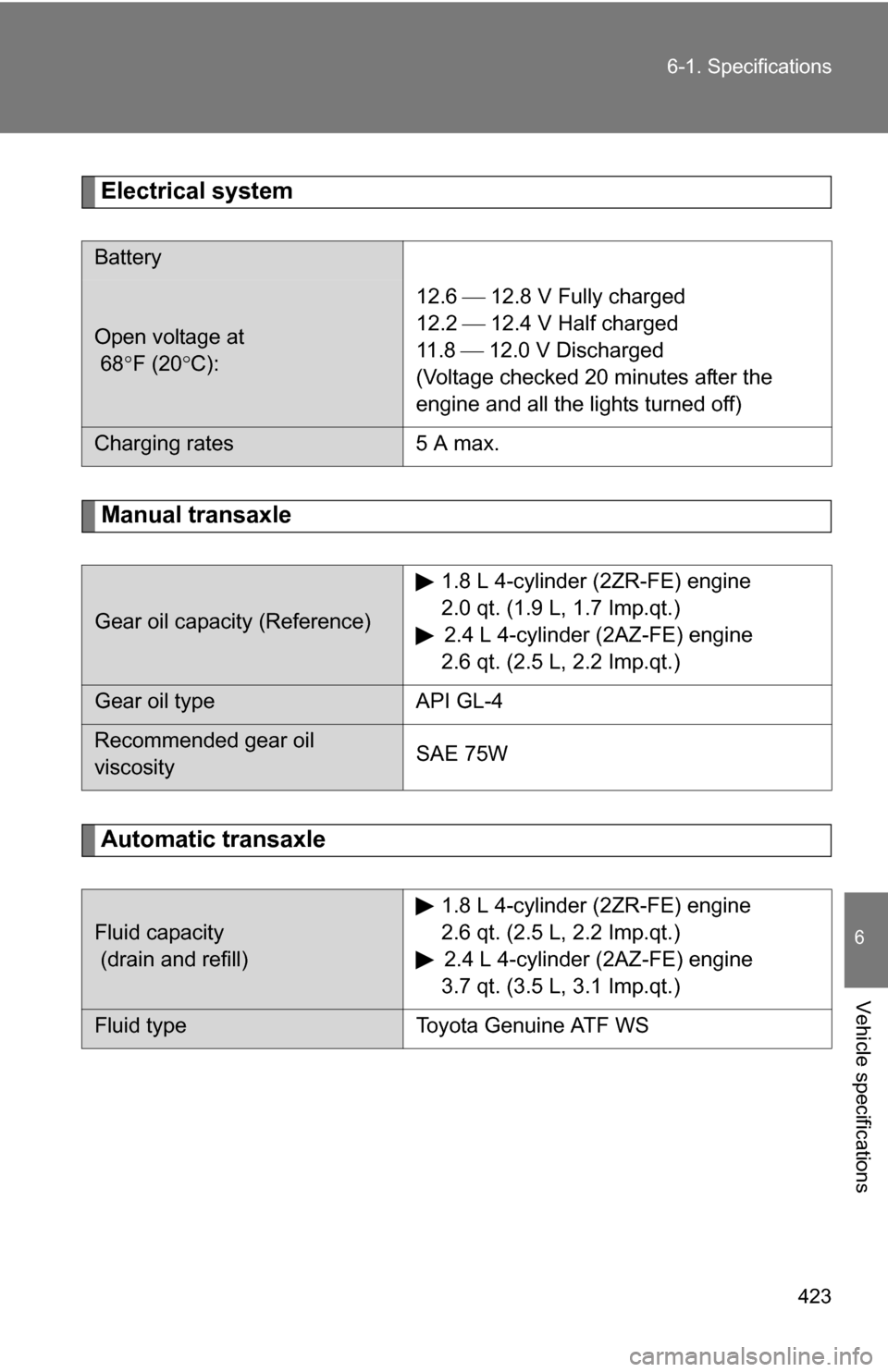
423
6-1. Specifications
6
Vehicle specifications
Electrical system
Manual transaxle
Automatic transaxle
Battery
Open voltage at
68
F (20 C): 12.6 12.8 V Fully charged
12.2 12.4 V Half charged
11 . 8
12.0 V Discharged
(Voltage checked 20 minutes after the
engine and all the lights turned off)
Charging rates 5 A max.
Gear oil capacity (Reference) 1.8 L 4-cylinder (2ZR-FE) engine
2.0 qt. (1.9 L, 1.7 Imp.qt.)
2.4 L 4-cylinder (2AZ-FE) engine
2.6 qt. (2.5 L, 2.2 Imp.qt.)
Gear oil type API GL-4
Recommended gear oil
viscosity SAE 75W
Fluid capacity
(drain and refill) 1.8 L 4-cylinder (2ZR-FE) engine
2.6 qt. (2.5 L, 2.2 Imp.qt.)
2.4 L 4-cylinder (2AZ-FE) engine
3.7 qt. (3.5 L, 3.1 Imp.qt.)
Fluid type Toyota Genuine ATF WS
Page 438 of 468
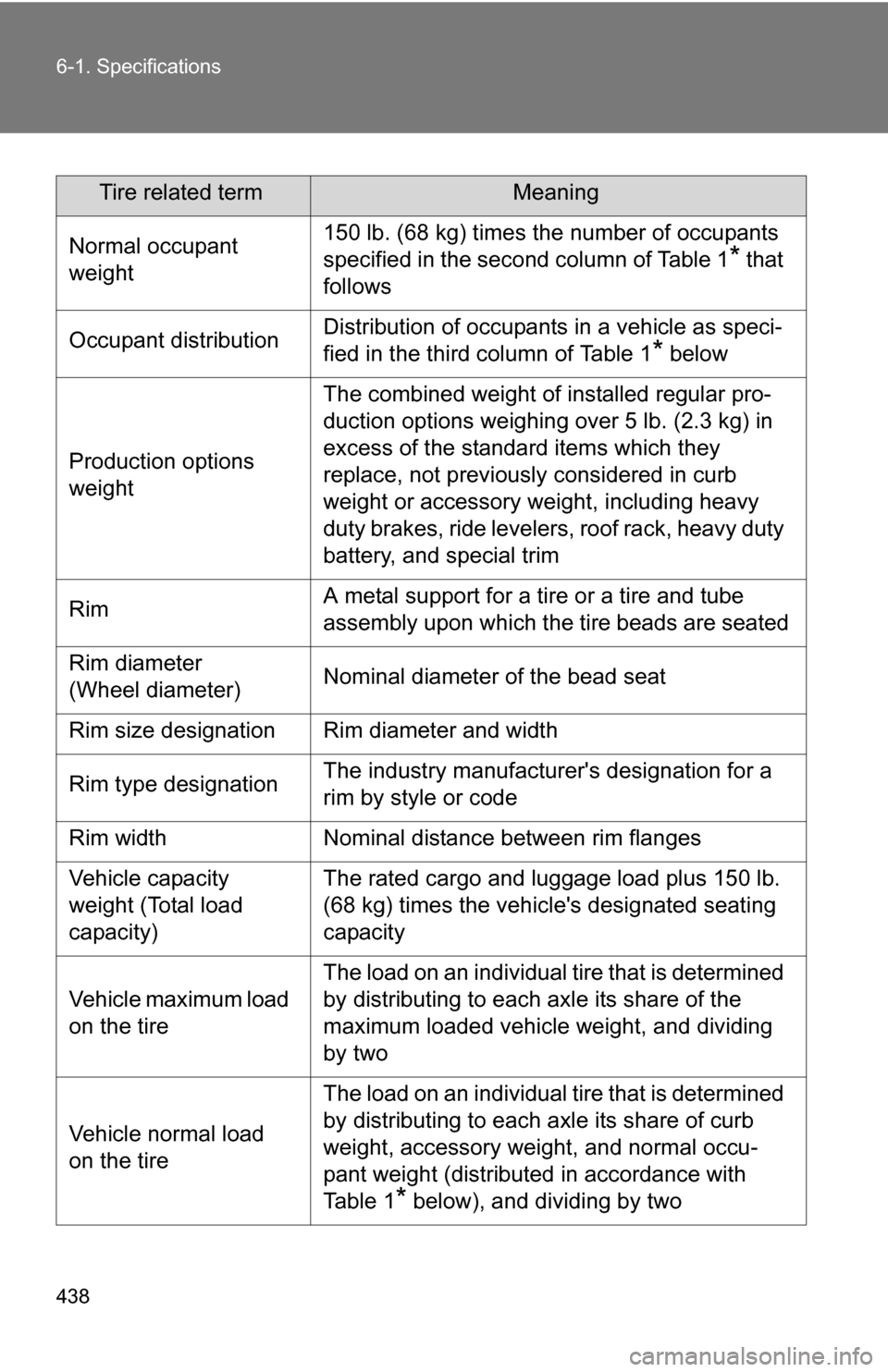
438 6-1. Specifications
Tire related termMeaning
Normal occupant
weight 150 lb. (68 kg) times the number of occupants
specified in the second column of Table 1
* that
follows
Occupant distribution Distribution of occupants in a vehicle as speci-
fied in the third column of Table 1
* below
Production options
weight The combined weight of installed regular pro-
duction options weighing over 5 lb. (2.3 kg) in
excess of the standard items which they
replace, not previously considered in curb
weight or accessory weight, including heavy
duty brakes, ride levelers, roof rack, heavy duty
battery, and special trim
Rim A metal support for a tire or a tire and tube
assembly upon which the tire beads are seated
Rim diameter
(Wheel diameter) Nominal diameter of the bead seat
Rim size designation Rim diameter and width
Rim type designation The industry manufacturer's designation for a
rim by style or code
Rim width Nominal distance between rim flanges
Vehicle capacity
weight (Total load
capacity) The rated cargo and luggage load plus 150 lb.
(68 kg) times the vehicl
e's designated seating
capacity
Vehicle maximum load
on the tire The load on an individual tire that is determined
by distributing to each axle its share of the
maximum loaded vehicle weight, and dividing
by two
Vehicle normal load
on the tire The load on an individual tire that is determined
by distributing to each axle its share of curb
weight, accessory weight, and normal occu-
pant weight (distributed in accordance with
Ta b l e 1
* below), and dividing by two
Page 457 of 468
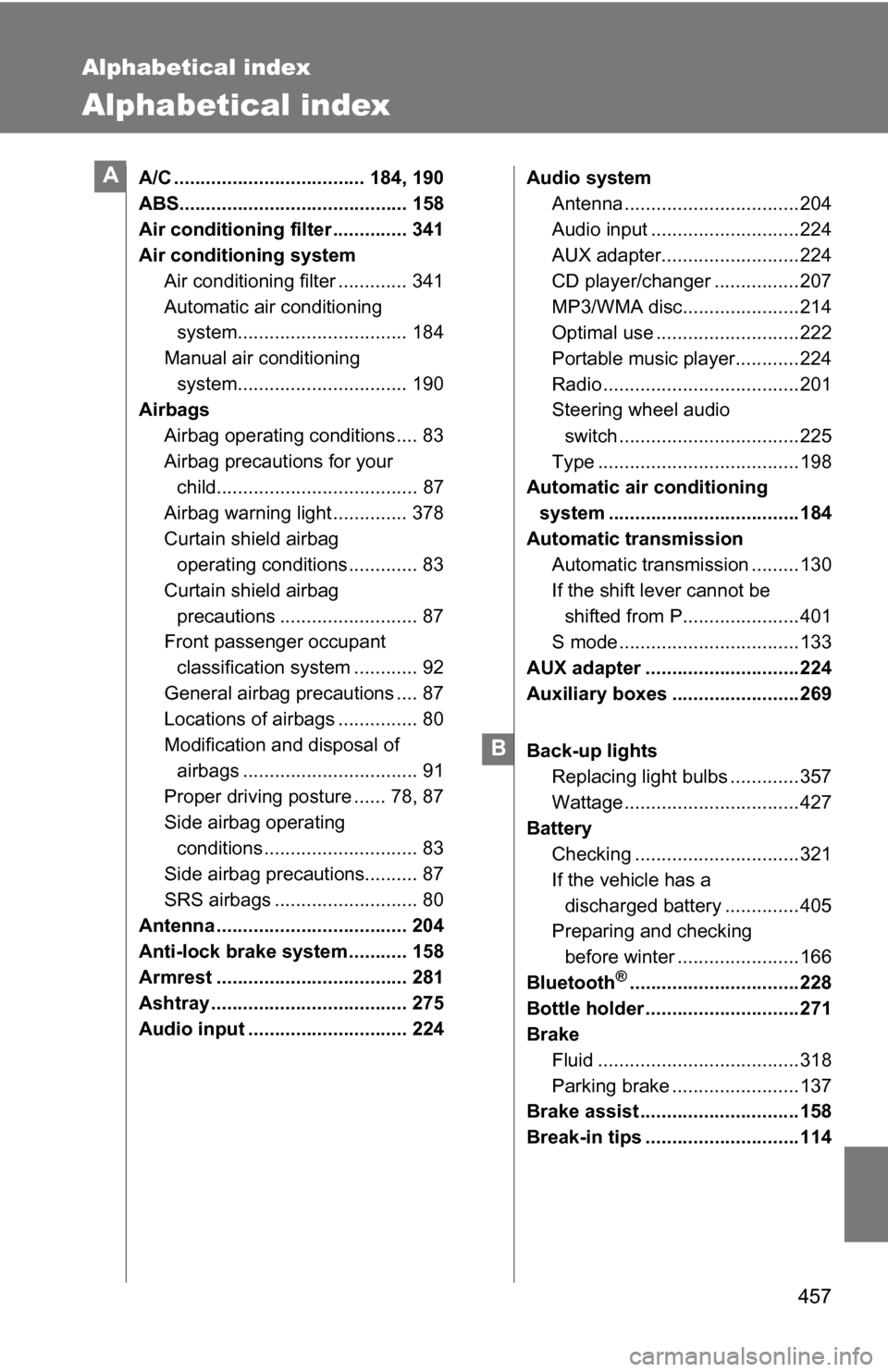
457
Alphabetical index
Alphabetical index
A/C .................................... 184, 190
ABS........................................... 158
Air conditioning filter .............. 341
Air conditioning systemAir conditioning filter ............. 341
Automatic air conditioning system................................ 184
Manual air conditioning system................................ 190
Airbags
Airbag operating conditions .... 83
Airbag precautions for your child...................................... 87
Airbag warning light .............. 378
Curtain shield airbag operating conditions ............. 83
Curtain shield airbag precautions .......................... 87
Front passenger occupant
classification system ............ 92
General airbag precautions .... 87
Locations of airbags ............... 80
Modification and disposal of airbags ................................. 91
Proper driving posture ...... 78, 87
Side airbag operating
conditions ............................. 83
Side airbag precautions.......... 87
SRS airbags ........................... 80
Antenna .................................... 204
Anti-lock brake system ........... 158
Armrest .................................... 281
Ashtray ..................................... 275
Audio input .............................. 224 Audio system
Antenna .................................204
Audio input ............................224
AUX adapter..........................224
CD player/changer ................207
MP3/WMA disc......................214
Optimal use ...........................222
Portable music player............224
Radio .....................................201
Steering wheel audio switch ..................................225
Type ......................................198
Automatic air conditioning
system ....................................184
Automatic transmission Automatic transmission .........130
If the shift lever cannot be
shifted from P......................401
S mode ..................................133
AUX adapter .............................224
Auxiliary boxes ........................269
Back-up lights Replacing light bulbs .............357
Wattage .................................427
Battery Checking ...............................321
If the vehicle has a
discharged battery ..............405
Preparing and checking
before winter .......................166
Bluetooth
®................................228
Bottle holder .............................271
Brake Fluid ......................................318
Parking brake ........................137
Brake assist ..............................158
Break-in tips .............................114
A
B
Page 458 of 468
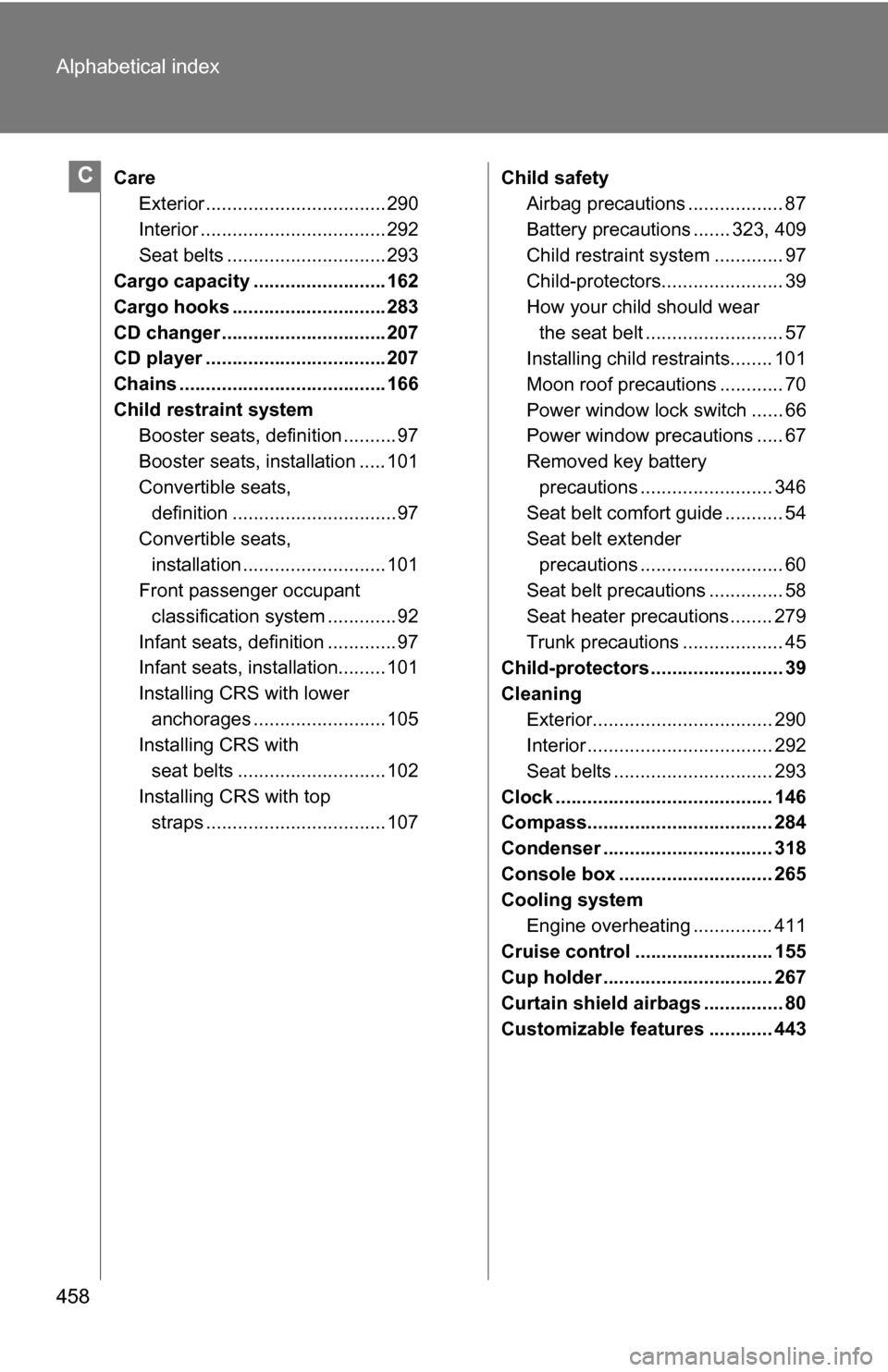
458 Alphabetical index
CareExterior .................................. 290
Interior ................................... 292
Seat belts .............................. 293
Cargo capacity ......................... 162
Cargo hooks ............................. 283
CD changer ............................... 207
CD player .................................. 207
Chains ....................................... 166
Child restraint system Booster seats, definition ..........97
Booster seats, installation ..... 101
Convertible seats, definition ...............................97
Convertible seats, installation ........................... 101
Front passenger occupant
classification system .............92
Infant seats, definition .............97
Infant seats, installation......... 101
Installing CRS with lower anchorages ......................... 105
Installing CRS with
seat belts ............................ 102
Installing CRS with top straps .................................. 107 Child safety
Airbag precautions .................. 87
Battery precautions ....... 323, 409
Child restraint syst em ............. 97
Child-protectors....................... 39
How your child should wear
the seat belt .......................... 57
Installing child restraints........ 101
Moon roof precautions ............ 70
Power window lock switch ...... 66
Power window precautions ..... 67
Removed key battery
precautions ......................... 346
Seat belt comfort guide ........... 54
Seat belt extender
precautions ........................... 60
Seat belt precautions .............. 58
Seat heater precautions ........ 279
Trunk precautions ................... 45
Child-protectors ......................... 39
Cleaning
Exterior.................................. 290
Interior ................................... 292
Seat belts .............................. 293
Clock ......................................... 146
Compass................................... 284
Condenser ................................ 318
Console box ............................. 265
Cooling system Engine overheating ............... 411
Cruise control .......................... 155
Cup holder ................................ 267
Curtain shield airbags ............... 80
Customizable features ............ 443C